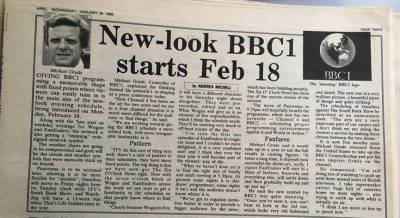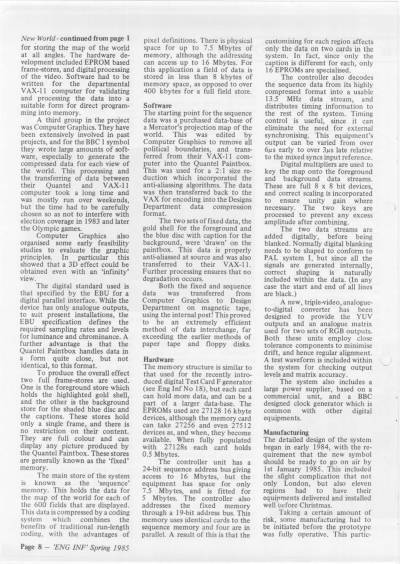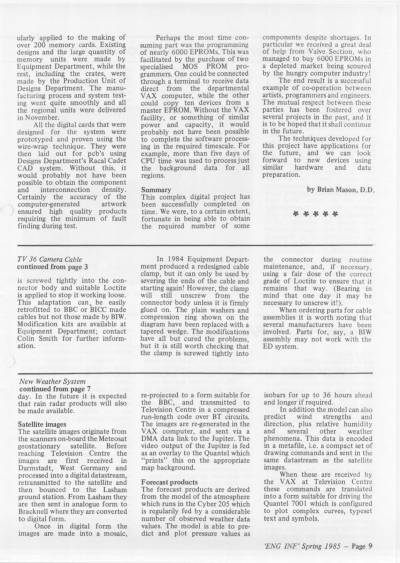Concept and creative process
The first BBC Globe generated by computer technology was part of the new BBC1 branding that was implemented in 1985. It was still based on the globe that had been in use since the early 1960s but modernised, using computer generated animation rather than the mechanical NODDY, the acronym for the mechanical device previously in use, the Nexus Orthicon Display Device. The ‘Computer Originated World’ (known by the acronym the 'COW') was the result. It was designed by Oliver Elmes and was in use from 1985 until 1991. Oliver Elmes worked with the BBC Computer Graphics Workshop and BBC Engineering Department to realise the new computer generated on-screen Identity. The design was played back on air from laser discs, cued from the Presentation Gallery.
Bill Gardner, Manager BBC Computer Graphics Workshop became very interested in typography at the BBC when he went to a US Conference in 1980 called ACM Siggraph in Seattle. There he met John Warnock, the inventor of Postscript and founder of Adobe, who gave a paper on how to anti-alias type forms on greyscale raster display screens, an idea that Warnock had worked on while at Burroughs Office Systems. Bill Gardner realised this was exactly the algorithm needed to render fine type on television. The CGW prototyped this technique on their old PDP 11 ICON computer and the results impressed BBC Research Department at Kingswood Warren who had been working on the same problem.
Supply contracts were procured from Monotype, Linotype, ITC and others for digital master fonts for the CGW’s new Quantel paintboxes. Programmer Colin Wrey wrote all the typesetting software for the CGW’s customised paintboxes. For the 1985 BBC1 Globe re-design project, Senior Designer Oliver Elmes adopted Monotype Times Roman, which had also been the font of choice for Senior Designer Charles McGhie in the 1983 General Election collaboration with the CGW.
Oliver Elmes and Brian Mason, a Senior Engineer from Engineering Designs Department approached the CGW to help them create a new computer animated version of the long-established BBC on-air Globe identity, which at that time was sourced from a physical mechanical model, cued live on air by the continuity announcer as required. Oliver Elmes envisaged a rotating, golden-shaded see-through globe, which Brian Mason reckoned he could store in a dedicated hardware device using compression techniques he had developed. He estimated that some 8Mb of memory chips would be needed to store a 10 second revolution of the Globe. Bill Gardner sourced the World shape dataset from an old university contact, Professor Gordon Petrie of Glasgow University. Senior Programmers Robin Vinson and Ewen Maclaine wrote the necessary software on the Department’s twin VAX 11/750 computers and data-linked custom-built Quantel Paintboxes. Their software animated a full revolution of the Globe in the form of 600 fields of even and odd 625 lines of TV. Each field was then compressed and converted to a tape data file to send to Brian Mason, to load on the memory chips inside his ‘black box’ device.
The CGW prototyped the full animation on a borrowed early writeable videodisc which showed the benefits of computing the rotational movement on ‘fields’ rather than frames. It gave a supremely smooth movement when played out, coupled with the advanced antialiasing software which the CGW had developed in-house.
It was a remarkable interdisciplinary team effort, bringing together the considerable skills of BBC Graphic Design, BBC Engineering Designs and the Computer Graphic Workshop which achieved a very successful Ident for the Channel which lasted from 1985-1991.
More Information
BBC1 - Globe Computer Originated World newspaper articles

BBC1 - Globe COW newspaper article 20/02/85

BBC1 - Globe COW newspaper article 30/01/85

The Spring 1985 edition of the BBC quarterly engineering staff information publication ‘ENG INF’ featuring the collaboration between BBC Engineering Department, BBC Computer Graphics Workshop and Oliver Elmes, BBC Senior Graphic Designer which brought the new Computer Originated World (aka COW) to the screen.

Bright New World article 2

Bright New World article 3
